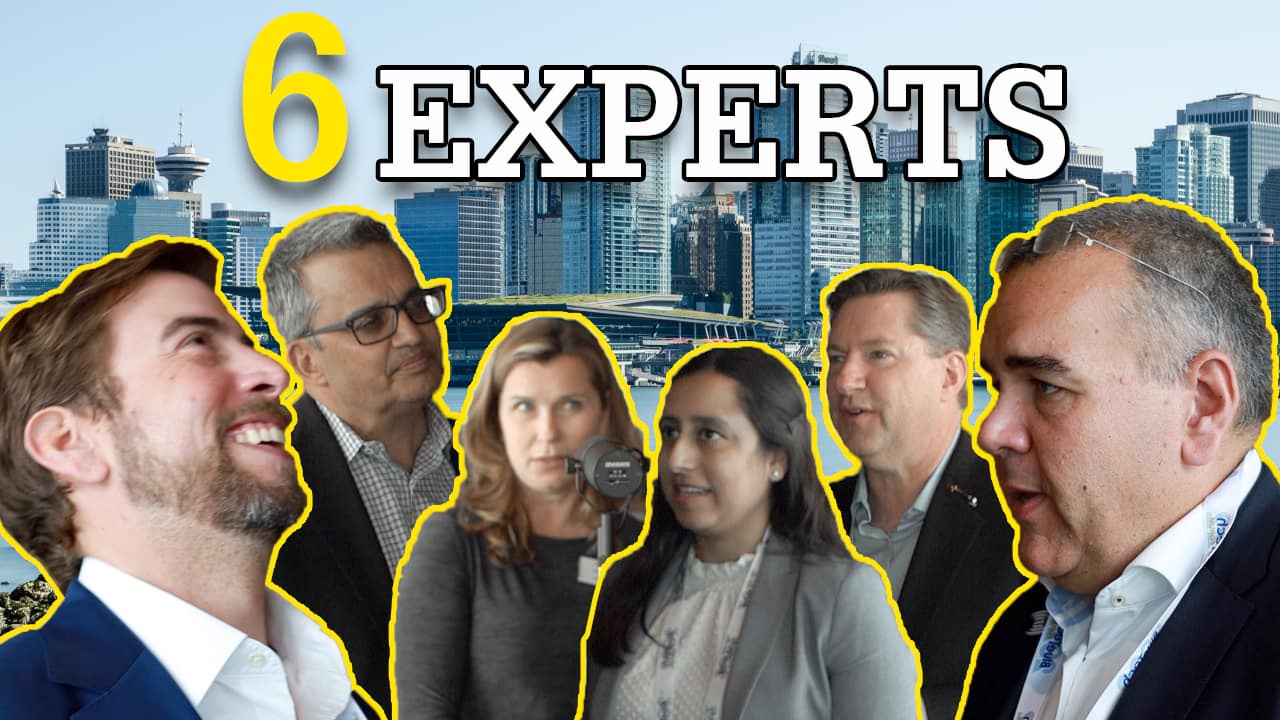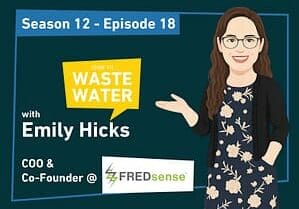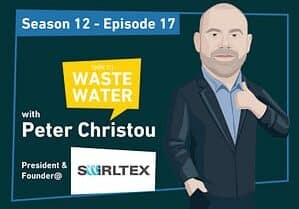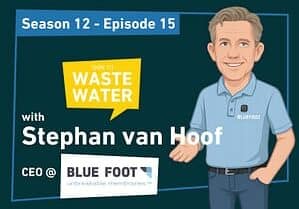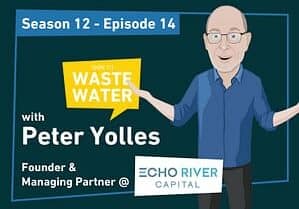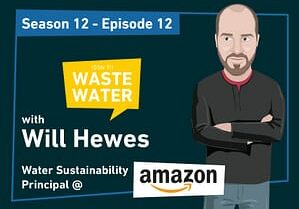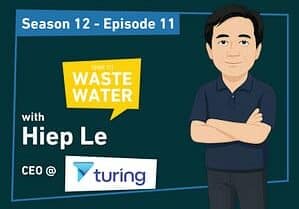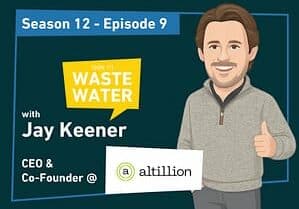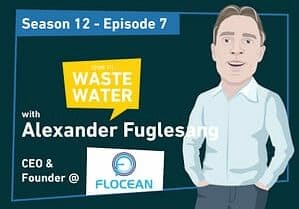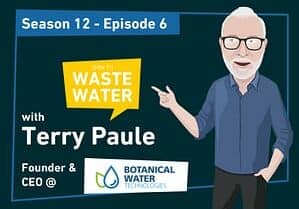BlueTech Forum 2022’s Theme was straightforward: Radical Collaboration for Regeneration. I got to chat with 6 industry leaders about their take at the matter!
with:
🎙️ Menno Holterman (President & CEO @ Nijhuis Saur Industries)
🎙️ Snehal Desai (EVP & Chief Growth and Sustainability Officer @ Evoqua Water Technologies)
🎙️ Ralph Exton (Chief Marketing & Chief Digital Officer @ SUEZ – Water Technologies & Solutions)
🎙️ Kimberly Kupiecki (Director & Global Leader Sustainability ESG, Advocacy, Communications @ DuPont)
🎙️ Jon LIberzon (VP & Head of Business Development @ Tomorrow Water)
🎙️ Kamakshi Sharma (Director of Marketing and Strategy @ Aquatech International)
Radical Collaboration for Regeneration:
What we covered:
🖐️ Radical Collaboration for Regeneration – What’s in it for you? (00:51)
🚶♂️ How does Radical Collaboration translate into a company’s actions? (05:59)
💰 Is M&A a way to collaborate? (11:16)
💬 Tomorrow Water & Aquatech’s Elevator Pitches (17:24)
👼 Was collaboration the key to Evoqua’s rebirth? (19:39)
🚀 How does SUEZ interact with the water start-up ecosystem? (22:26)
🌱 Walking the Sustainability Talk (23:41)
💽 Leveraging synergies between datacenters and wastewater treatment plants (26:31)
🎬 Reality check: where do we start from? (28:10)
🌆 How do we better integrate water infrastructure with urban design? (30:12)
💪 How does success look like in the future? (34:04)
🤝 How is it to be back to live interactions? (42:56)
🔥 … and of course, we concluded with the 𝙧𝙖𝙥𝙞𝙙 𝙛𝙞𝙧𝙚 𝙦𝙪𝙚𝙨𝙩𝙞𝙤𝙣𝙨 🔥
😅 Can you name one thing that you’ve learned the hard way? (46:27)
⌚ What is the very very very latest thing you’ve learned? (48:32)
Resources:
🔗 Have a look at the BlueTech Forum website
🔗 We mentioned The History of US Filter
🔗 and discussed The Veolia/SUEZ merger
🔗 we addressed The Dynamics of Water Innovation
🔗 Kimberly Kupiecki recommends reading The book “Flourish”
🔗 One topic to watch: The (slow) rise of Reuse
Special thanks to Paul O’Callaghan, Aoife Kelleher, and Annyse Balkwill for the invite and support during this amazing Forum!

is on Linkedin ➡️
Table of contents
- Radical Collaboration for Regeneration:
- What we covered:
- Resources:
- Full Transcript:
- Radical Collaboration for Regeneration – What’s in it for you?
- How does Radical Collaboration translate into a company’s actions?
- Is M&A a way to collaborate?
- Tomorrow Water’s Elevator Pitch
- Aquatech International’s elevator pitch
- Was collaboration the key to Evoqua’s rebirth?
- How does SUEZ interact with the water start-up ecosystem?
- Walking the Sustainability Talk
- Leveraging synergies between datacenters and wastewater treatment plants
- Reality check: where do we start from?
- How do we better integrate water infrastructure with urban design?
- How does success look like in the future?
- How is it to be back to live interactions?
- Rapid fire questions:
- Other Episodes:
Full Transcript:
These are computer-generated, so expect some typos 🙂
Antoine Walter: Hi, and welcome to the Don’t Waste water podcast. I’m your host, Antoine Walter. And today I have a very special edition of that podcast because I have not one, not two but, much more guest, which came to that microphone. The reason it’s pretty simple. I’m here in Vancouver for the BlueTech forum under this.
Very intriguing theme of radical collaboration for regeneration. I had the chance to speak with several people which came on that very microphone and shared their thoughts on the topic and beyond, and without further due, I let you discover the wisdom they shared.
Hi Menno. Welcome to this mini version of the show.
Hi, Kimberly. Welcome to that mini version of the show.
Hi, John. Welcome to that mini version of the show. Hi there. It’s great to be.
Radical Collaboration for Regeneration – What’s in it for you?
Hi Snehal. Thanks for stopping by my microphone. I have a couple of questions for you. The first one is what attracted you to this theme of radical collaboration for regeneration?
Snehal Desai: First of all, thanks for the conversation. Antoine, there’s a few things about just the topic alone that really hits to the core of how we evoke with think about business, but actually how I thought about it for a long time, which is you can only go so far by your. Together, we can go further. I think collaboration really is the core of what we’re all seeking to be able to get together with like-minded compatible complimentary partners, to be able to help us on this journey of change in the water industry.
The radical nature of it is actually I think. The we sometimes think of traditional partners in the world where we are working and living in watersheds and ecosystems. Sometimes we don’t bring all those stakeholders into the conversation. And I think that’s what we’re seeing here in Vancouver is not just the traditional water industry talking amongst itself, but getting the end users involved, NGOs involved listening to politicians.
I mean, there’s a dynamic that’s actually most important, I think to get every, everybody into the mix. Cause ultimately. Everybody in that mix is going to have something that they can do to help move the whole issue forward.
Menno Holterman: The theme, I think, is really reflecting what we believe is necessary to solve some of the demanding water challenges around the world.
We, as a sector, the water sector to improve a lot over the last decade and if we really want to solve the water challenges, and if we look into that very dynamic. Situation around the globe, the negative impact of too much or too little water, climate change and geopolitical situation. The fact that many people still don’t have access to clean water, a lot of industries, which are limited at the moment in growth, simply because there’s not enough water available.
There is a lot we need to do in order to get water, the value it deserves, which is also part of our mission water. We believe that the radical. Collaboration in order to regenerate the planet is necessary.
Kimberly Kupiecki: We have to have radical collaboration to get to where we need to go with the speed, which we need to get there so that we can really change the trajectory of water in the context of climate.
As we’re seeing so much of our climate change through changes
Ralph Exton: in water, I think there’s more than one thing going on there in that theme, I was fortunate enough to be, actually be part of the advisors to the forum. To try and decide, like what do we want to try and tackle on things like that?
So when Paul introduced that as his concept, I think we all thought a little bit differently about it. And the one thing that I kept coming back to was, well, there’s the radical piece, which I look at more as, look, if we’re gonna do something radical, then we have to get out of our comfort zones, cuz you’re not gonna change.
Unless you get out of that zone and you try something new and different. So for me, that’s really the radical part of that. The collaboration part for me is essential, no matter what, from an innovation standpoint, which a lot of this event circulates around innovation, right? You can’t have true innovation or speed of innovation without collaboration.
So I think having collaboration in there is critical to be the catalyst for innovation, but collaboration does not happen. Without the interaction of the people, it’s all tied together. Very well. The regenerative part, I think that was the real interesting part of how this theme came together. Because if you look at themes of the past or of other conferences, events and things like that, it’s about, yeah.
Like we can make things better or less bad than they once were. But when you think of the regeneration aspects, then you’re truly looking at it as more of a dynamic change. And this is the way that you can really make it more sustainable
Jon Liberzon: for the long periods of time. Radical collaboration is really the core of our modus operandi at tomorrow water.
We’re not a huge company and. We have very big aspirations. And the only way to achieve those aspirations on a global scale is to partner with other innovators and thought leaders. Like we find here at this event, we’ve known Paul for a long time. He sits on the board of our tomorrow water project.
And it’s really been a pleasure to help make this come to fruition after 10 years that we haven’t been able to participate before. We’re really excited about taking advantage of this opportunity now.
Ralph Exton: So when you pull that all together, I think there’s just so much to unpack. And I think throughout the course of the event so far, we’ve been tackling.
All the different components and pieces of that. So for me, it was very exciting.
Jon Liberzon: Radical
Kamakshi Sharma: collaboration is something that we really need right now, as we’re for lack of a better word, brushing off the dust and getting back into in person contact. So much of the last two and a half years has been behind computer screens and sure.
Teams, meetings, and huddles over message and so on are great, but actually collaborating requires meeting each. And sometimes talking to the person next to you who is not in your organization and learning their perspective, which may be completely different than your perspective, but really give you something to think about and try to implement yourself.
In your day to day work.
How does Radical Collaboration translate into a company’s actions?
Antoine Walter: And how would you bring that radical collaboration home at Evoqua?
Snehal Desai: Well, I think it starts with just the willingness to partner, whether it’s partnering very much with our customers and not just make it a tendering situation, but really working with them to understand their goals, understanding sort of where their pain points are, figuring out what their.
Appetites are, but really just that dialogue, right? That’s just in the customer side. We also think about it from a technology perspective. Well, we have a number of technologies in. We don’t have everything. And we’re often willing to look at our own solutions say, is that really the best answer? And when you don’t have the best answer, then you turn into the market.
You turn into a supply chain, you turn into say complimentary providers to look for ways to put together a holistic solution. There might have been a time where one thought, well, I’m only going to use. My stuff, but the complexities are so great now. And the innovation has continued to evolve. So it’s very difficult for any one company to have everything.
And so the collaboration is how we go about doing that, even when it comes to putting together solutions for customers. It’s something we’re doing already at Evo. I think this just gives me more impetus to make sure that we continue that journey cuz there’s quite a bit more
Antoine Walter: we can do. You’ve been opening the session on innovation this morning.
Yes. With all these companies, 20 companies that pitch for 20 times one. Is that the way that sewers looks. Collaboration by thinking that’s a way to enhance innovation.
Ralph Exton: I think it’s a piece of the equation for sure. It’s not the only piece of the equation, but it’s definitely a piece. Is it the key piece collaboration for sure is a key piece who we collaborate, how we collaborate and to what level we collaborate.
That’s where it’s it may be a little bit different. So, for example, there’s some aspects of innovation that we do. That’s highly confidential, and we’ve got very small teams working on very sophisticated technologies and you really have to do it that way for large companies and for companies to protect their intellectual property.
But there’s certain degrees of innovation that go beyond sort of that intricate core of technology development, where you do need, or you should want to partner with others on a much more open basis. Because you can spur a lot of creativity and you can combine technologies that may exist somehow some way in our portfolio with technologies that exist with other companies into something that more makes a, you know, a one plus one equals three type of equation.
And that’s where you know, an event like this where we get to meet and potentially collaborate with a lot of. In some cases, smaller startup companies or other companies that are just working on something new and sophisticated, and they have a piece of the equation, but not the whole solution.
Well,
Kimberly Kupiecki: certainly, I mean, bright blue world is a good one. Just having met Paul from years ago. And him coming to me with this idea of a documentary for positive optimistic story with really nothing more than a few. Pages on a PDF. I was just inspired by the concept and this idea of talking about solutions versus just the doom and gloom.
Like there’s nothing we can do that was somewhat serendipitous. And then there was just sort of a snowball effect of how that film ended up being, you know, so successful and attracted, you know, star power and Hollywood power. And he would’ve known, I mean, he’s a researcher, I’m a, you know, chemical engineer turned marketer, like who would’ve known something that would’ve.
Menno Holterman: I think I shared yesterday many examples of projects, which were probably a couple of years ago, not possible. And only when bringing together all the different stakeholders. And convincing each of them and trying to find the right way. We have been able to solve some of these water challenges. For example, water reuse.
It’s a common topic, which people think it’s something only for countries which are really facing droughts around the equator, which you see now everywhere. And also in Europe, many countries, which are facing droughts. And I showed you the example yesterday of one of the largest poultry processing plants in the world who is at the moment fully, depending on reuse of all the treated effluent in order to meet.
Clean water and drinking water demands. If you look into resource recovery, you see that that was a topic 10 years ago, which was very high on the agenda of the blue tech research team and pulls own vision to, Hey, how are we going to get resource recovery really implemented? And now there are technologies.
Now there are full scale references. There are business cases, which especially now is the higher energy prices. For example are going to accelerate and create more opportunities. And this. I think just to name a couple of examples of radical collaboration, where different stakeholders, public, private universities, institutes, suppliers.
Have to work in a different way together than we are used to. So the very traditional way of, let’s say an end user working together with a consultant to solve some of the challenges and then bringing tenderer to the market. Yeah. That’s changing. We have a lot of clients who are seeking our active advice and help it’s.
Okay. This is the challenge. Looking into the future. It will become even more challenging. Regulations are becoming more or strong. An expected development, global economy, supply chain restrictions, pandemics clients are looking today more for let’s say flexible solutions, modular solutions and new technology, real innovations game changing innovations, which are gaining attention and market share today.
Is M&A a way to collaborate?
Antoine Walter: You, you mentioned this new technology is. And the combination of all of those and having probably the right portfolio to bring the right solution at any place that is something where your company has been quite active over the past months is that’s another way to look at radical collaboration. You’re collaborating with always more companies, which join your Nyhus family.
No,
Menno Holterman: That’s true. It started already when Naas and se decided to join ties two years ago, in order to build a strong European, industrial powerhouse and with the very rapid expansion and all the acquisitions we have successfully completed over the last let’s say, 12 months, we are indeed expanding our knowledge base.
The experience we have learned that local presence is absolutely critical, especially also during the COVID pandemic, clients were fully relying on the local technical support in order to get their plans up and running, or keep them running and provide all the necessary technical support. We need to make sure that we have access to the technology for the future.
And we are building what we call our one stop shop for water on demand, where we are very critically looking, which technologies really have the future in order to deal with all those challenges. Many of our industrial and municipal clients are facing around. The world that comprehensive portfolio, which we now have developed and built together is going to be the basis for the future.
Especially as we see that more and more clients are also asking us to take more responsibility and as a system integrator and a solutions provider, we don’t want to rely on promises of O we want to know that core technologies by heart. We also have a strategy that we manufacture as much as possible ourselves with our global manufacturing facilities.
We’re expanding at the moment and building one. We’re going to build one of the largest manufacturing sites in Europe, in the Netherlands. We’re expanding in Italy with the recent acquisition of Aqua in the United States. We’re now also starting up our manufacturing capability in Knoxville, Tennessee, it’s really globalizing, but at the same time, we need to make sure that we have the right knowledge about the technologies, which are commonly applied in the different regions and work on the innovations for the future.
Antoine Walter: You want to be globally local because people want to be closer to their suppliers. You want to go over the full vertical. And to deliver not just one piece of the puzzle, but really a solution which really connects to them. And you want you to stay radically in innovative to stay on top of the game.
You said comprehensive solutions. Do I have to understand that your journey is over? You don’t have more announcements in your pockets?
Menno Holterman: Don’t be afraid. No. It depends from industry to. If you look for example, in the food industry to solve the water challenges over there, it requires a slightly different portfolio of technologies than for example, in the renewable energy space.
We’re quite successful. Also now in the semiconductor electronic manufacturing, there are also we need to have different technologies, which we did not have in our portfolio. That’s one of the reasons why we acquired ache historically Nash is coming from the wastewater treatment. We developed over the last eight years more into processed water reuse.
But in order to close the water loop, we also needed to have leading technologies in our portfolio on the clean water side and the ultra pure water side. Now that has been the reason, for example, for that acquisition. Now recently in the United States, if we look into via mobile water services, we see a huge.
Growing demands either to deal with emergencies or to help clients out for the next 2, 3, 4 years. We see a lot of clients who don’t know, given all the uncertainties at the moment around the globe, what their manufacturing requirements will be one year from now, two years from now, but they still, they need to fulfill the legal obligations.
Temporary mobile solution is a perfect perfect altern. And for us, it means eight, nine years ago, we started to basically transform Niha from a system supplier into a solution provider. And now with the help of sure. And E Q T, who is the main investor in, in, in the sewer company and the largest European infrastructure investor, we’re also carefully looking into growing demand for water surface.
So more clients who ask us to basically finance operate and maintain on their behalf. Given the growing complexity of remove, reuse, reduce, recover, the changing regulations. They want to rely on strong, reliable partners. That comprehensive portfolio of technologies is helping us. Cause I think today nine out of 10 clients, we can help solving their water challenges, but we will keep looking.
That’s also one of the reasons why we are. Looking for that holy grill or that great, brilliant idea, which is going to basically re replace one of our leading technologies. If you engage
Antoine Walter: with those companies, well, this is the kind of engagement you can. I mean, there’s not only acquisition, there’s also partnership.
There’s also smaller stage investments. Yeah. What’s your politic.
Menno Holterman: That’s a very good question. And first of all, we are very proud at one of the companies, which we believe is one of the most promising scale. It’s also actively today presenting their value proposition, similar sanitation. That’s an example how we are working with promising startups.
I think we are not the right. Partner for real startups, we support, we help a lot of entrepreneurs. If they pass by say, Hey, can you reflect on our IDs? What’s your view? We rate companies, we scout startup companies, but really when we believe that a company is ready to scale up, when we can bring them to the global market so we can help promising startups to really scale.
And that is what we are doing now. So rather in growth stage,
Antoine Walter: not in the early stage,
Menno Holterman: not in the very early stage. Okay. When it’s really radical, when we say, okay, this is something to jump on, we will consider that we are following two, three opportunities today. Mostly we are looking for companies where we can bring that technology to the global market.
So one of the recent acquisitions of bios, for example, who is leading in nitrogen recovery, it’s a new technology. We looked at them already. Couple of years, NAS decided to develop some alternative technologies themselves. And now it’s the right time to really join forces and scale up this alternative for destroying nitrogen and recover fertilizer from nitrogen directly.
Now it’s the momentum to really scale up and make this technology, the preferred technology for. Municipal industrial clients in the future. That is really where we are trying to work together with the right people, which we can help and who can help us solving these very demanding water challenges.
Tomorrow Water’s Elevator Pitch
Antoine Walter: What would be elevator pitch to Tomorrow Water?
Jon Liberzon: Tomorrow Water leverages a portfolio of really unique technologies that are all paradigm shifting technologies focused on the. Water challenges, whether that’s our anox and thermal hydrolysis technologies, which are helping to achieve the vision of true net energy, positive wastewater treatment is an energy producing system, or whether that’s our Proteus biofilter platform, which is leading on climate friendly solutions for carbon diversion for wet weather.
Treatment for storm water flows, wet weather flows, or even reclamation of precious public spaces by really taking treatment plants and turning them into public parks and other valuable infrastructure might be a public space. And in some cases with our new co flow project, really integrating other industries for a true industrial circular ecosystem,
Aquatech International’s elevator pitch
Antoine Walter: what would be your elevator pitch to
Kamakshi Sharma: Aquatech is a provider of water technology as a service to help customers sustain their sustainability goals.
We. Try to provide water technology in, at a predictable cost. And when we talk about water technology as a service, we really talk about holistically giving, not just the technology, but the knowhow as a company Aquatech has always led with their technology. We don’t wanna just provide the technology in a, in an, in isolation.
We wanna work through the complete solution while leading with the technology. So that includes offering our knowhow, working with a customer. Understanding their operations, integrating digital integrating operation control and other types of mechanisms and offering it at a predictable cost. So much of a plant challenges are faced after the plant is in operation.
So working to give an end to end solution that leads with the technology is really what we wanna do. And that requires offering it as a service. So not. Putting the technology in and walking away, radical collaboration is really how we get there.
Was collaboration the key to Evoqua’s rebirth?
Antoine Walter: When we discuss a VO. If you look at a terrible example of a company failing you, look at us, filter us filter. Plus VI was a failure, us filter. Siemens didn’t work that well. And then everybody’s like, oh, that company is doomed. And then a couple of years later, you have Evoqua, which is one of the most striving companies right now in, in the water scene.
And it’s the same company. What changed? It sounds to be the culture, the collaboration within the company. I
Snehal Desai: think it’s an, it’s a reasonable observation. I think historically it’s a very reasonable observation. I think a few things have changed and it’s absolutely the culture. It started with the private equity owners that, that came in when they bought the business from Siemens.
But really most importantly, the management team they put in. And mind you, I wasn’t there at the time, so I’m not speaking on while I, it was great. I was actually very keenly watching the situation because as far back as 30 years ago, my first sales job was selling on exchange and RO to a legacy us filter company.
And so I’ve watched the journey, but what is different now is. A maniacal focus on the customer, which I don’t think was the case previously. There was just this idea that, well, we have everything let’s go buy things really more internally focused. I think it’s also a management operating style that is very agile, you know, having discipline of execution.
Meeting your commitments. We focus much more on service than ever because customers particularly in the industrial sector, water is not their business. Water is a means to an end. And so they’re looking for reliable partners and that focus on making sure we’re reliable. We’re close to where the action is.
We have an operating system that actually focuses on those real operational metrics, very diligent about our acquisitions. So that’s not random, but it’s filling. Problems and gaps in our roadmaps around technology or market. All of that has turned into the secret sauce if you will. And I think the other thing to point out is that our business has evolved to the point where 70% of our business is in industrial, maybe 30 in municipal and within the industrial segment.
There’s no one end market and it’s healthcare. It’s pharma, it’s power, it’s food and beverage it’s semiconductor. And that diversity of end market has also really served us well when it comes to resilience and earnings and execution and scale of the senior management team. And really, if you go down a level, these are not in water industry veterans.
These are people that have come from other industries that have been attracted to water, but they bring a different operational mindset. And I think all of that has gone into what is currently. Our pathway with Evoqua.
How does SUEZ interact with the water start-up ecosystem?
Antoine Walter: You mentioned that ecosystem of small companies, innovative companies, early stage startups, growth stage startups. What is the relationship you want to have as C S WTS with that ecosystem in the
Ralph Exton: digital. Things are moving very quickly. There’s so many players that are trying something new, something different, and it’s a rapid pace of development.
So when you’re thinking about the digital ecosystems, there’s not one. Piece. That’s gonna be like, okay, now we’ve got digital solved, right? There’s not one code or one bit of software or whatever it truly is an ecosystem. So it’s how well you put all these different parts and pieces together and how well you can integrate ’em so that they’re talking to each other.
When you look at smaller startup companies that are doing, for example, digital types of things, and you already have an ecosystem and an infrastructure, and you can bolt something on and interweave. Into your plans, that’s pretty advantageous. And it certainly is for us with the way that we operate.
Walking the Sustainability Talk
Antoine Walter: You mentioned how you try to work with your customers and how it starts with their challenges. And then you try to find the solutions to that extent. Your approach to sustainability is very interesting because. The footprint, which everybody talks about. I mean, how can I do good with my footprint?
Yeah. But as a water company solving the footprint is pretty easy. I’m putting brackets on easy, but still is pretty easy. We don’t have that much of impact ourselves, the company, but you are walking a different talk saying, yes, we solve the footprint, but we also go for the hand print, which is much more ambitious.
Yeah.
Snehal Desai: And I think the way we’ve talked about this is when I talk about hand print and when we talk about hand print is evoke what we say. Our ability to deliver either a product technology or an entire solution is enabling something for the customer. Now they may have water goals, so we’re helping them meet their water goals.
They may have energy goals, and by the way, the water system is a contributor to that. I give you a really simple example. Data centers are using water using quite a bit, but if they choose the right technology and they keep the water clean enough, the reduction of following and a cooling tower goes toward.
Which goes toward their carbon footprint. The translation we’re trying to make now is that our hand print is more than just a water story. Our hand print can be an energy story. Our hand print can be a food story. Water is at the center of those conversations, but what are we really trying to do? We’re reducing food miles.
We’re actually reducing the intensity of energy of transport in general. That’s where we’re going. We’re saying, look the water is a pathway to being able to meet some of your other. Fundamentally, what we’re finding out is that many of the customers in those markets are not water experts, and they’re looking for a trusted partner to help them figure out what are my options here.
And that’s where the hand print really is starting to show up pretty convincingly. We’ve had a way to dimensionalize the impact of water beyond the traditional gallons, quality CapEx, OPEX. I mean, that’s all true. The compounding effect of that hand print is amplified. When you think about what is that company able to.
How are they achieving the best examples over the last three years are our ability as a company, because we were servicing some of the pharmaceutical companies making the vaccines. They were not necessarily all prepared for the amount of water they were gonna start using. And we were able to monitor those with electronics.
We were bringing in mobile equipment, we were keeping them moving and that can allow them to keep the timelines. Now you translate into lives. That’s a hand print story that nobody can. Put a number two, but it’s an impactful one. We
Menno Holterman: are part of the first French company who took a green loan. We are committed to, to reduce the water consumption.
We are committed to change from fossil fuel to renewable energy. We’re investing a lot in order to make sure that we have an equal workforce between women and men.
Leveraging synergies between datacenters and wastewater treatment plants
Antoine Walter: Actually that is an incredible example of radical collaboration. You have this flagship partnership with data centers. Can you tell
me
Jon Liberzon: a bit about it? Sure. So far we’ve already established partnerships with Arcata. It’s an engineering consultancy that knows how to design data centers as well as wastewater treatment plants.
We’re also partnering with Samsung. We. Looking at this concept of citing a data center on top of a wastewater treatment plant. There’s a lot of fantastic synergies that can occur when you take those two elements and put them together. First of all, location data centers would love to be close to the heart of the processing action, especially in a lot of new edge computing applications, close to the fiber backbone in the heart of these urban centers.
And that’s where we have of course, aging wastewater infrastructure that is desperately in need of upgrade on top of that data centers need. And there’s no better heat sink, really an unlimited heat sink of tremendous flows through these wastewater treatment plants. So we can utilize that for cooling.
We can actually upgrade the plant with resources available from the project and produce more reuse water than is needed for the data center. And so the data center can actually become net water, positive producing water for the community while achieving its cooling. Additionally wastewater treatment plants.
As I mentioned, we’re interested in turning wastewater treatment into an energy production plant by integrating new Codi digestion facilities. We can produce megawats of clean energy that then the data center can utilize to become less carbon intensive or maybe even carbon neutral.
Reality check: where do we start from?
Antoine Walter: When it comes to that hand print topic, you have to educate them and to come and say, look, you can be doing that that, and that. Or do they actively come to you and say, We are committed to some pledges and we would seek some help. It’s a little
Jon Liberzon: bit of
Snehal Desai: both. It’s a little bit of both, but I think the most success we’ve seen is where a company has already made a commitment or has already shown an indication of wanting to go on this journey.
But oftentimes they don’t have all the answers of how they’re going to get there. And they don’t think about it that way, because they haven’t gone and done the work to math. And I’m not saying that they wouldn’t know how to do it, but they just haven’t tied the time in saying, look, if you use a versus B take, for example, using UV, instead of chemicals for getting to disinfection, when you look at the embedded carbon inside that chemical solution.
Yes, it works. But if you were to switch to UV, in some cases, You not only are gonna minimize the chemical burden, but you’ve also increased reliability because you’re not waiting for the next tanker to arrive and you haven’t exposed yourself to supply chain. There’s a lot of other things, right. But if you don’t put all of those things on a piece of paper to show, these are all the things that are possible.
If you choose a versus B, they don’t have the time to come up with all that on their own. But it’s in the case where they’ve already made a goal and people are like, well, we don’t know how we’re gonna get there. That’s really the. Ground cuz you get motivation
Antoine Walter: and then your other case where they don’t have all of that
Snehal Desai: laid out and then you lay it out in front of them.
And mostly that turns into an envi. It turns into an economic ROI that happens to have an environmental ROI with it because if I’m saving you energy, then that’s money. If I’m helping you reduce the amount of water you buy from the local municipality or get charged by the waste facility, that’s an ROI, but did they accomplish water recycle while they were at it?
Maybe, and maybe they now have a water goal that they can speak to that they might not have done before. In all cases, it’s gonna need to be an economic ROI. It’s just, how do you put enough of that on the table for them to get the credit for having taken a different path?
How do we better integrate water infrastructure with urban design?
Antoine Walter: When you get footage from a wastewater treatment plant, it’s always taken from the sky and it’s always beautiful. And you brought that just into light with the, those pictures of the fence, which is what we really see of the wastewater treatment plant first. Brilliant marketing. And that’s brilliant message because it’s crisp and everybody gets it beyond that.
Do you think your approach of making this wastewater treatment underground and originating the space on top of it? Do you see that becoming mainstream? And
Jon Liberzon: to which extent? Well, we hope so. I’ll say that the core of our technologies are all intended for and do achieve, you know, cost parity and competitiveness, even in classic treatment traits, you know, in north America, it’s not as common right now to put wastewater treatment underground.
And we’re selling into that market. We’re coming in for advanced primary treatment applications for secondary upgrades, a lot of different plant upgrades that they’re not underground, but it meets the needs of the plant. So first of all, the baseline is you have to be. On top of that, being able to leverage the added value to a community to then go ahead and build on top of that is really where the extra value is.
In order to do that, people have to see that value. When I started working with tomorrow water, I came on board with this company about five years ago. The first thing I did is to fly to Korea and go to one of these flagship plants. I was used to plants where you come in and there’s a fence and you have to talk to the security guy.
And then, you know, he calls somebody and then the gate, the fence slowly opens. And then you walk in, well, it was a totally different experience. I got there to se and we got off of the bus and we literally walked into a. There was a wastewater treatment museum. We did a little tour. We went upstairs, we had a cappuccino overlooking the beautiful park, and then we went outside and we sat on a park bench on top of the primary filter.
And we, you couldn’t tell where we were. So that’s a very inspirational experience and it’s an inspirational experience for people that have it, but it’s an even more amazing experience for the people that are there for other reasons, because if you have a business, that’s next door to that facility, if you have a home that’s next door to that.
You have a completely different interaction with that public service. So there are starting to be more and more projects to try to integrate these critical infrastructure elements into the urban landscape and really reclaim public space or reclaim land for other high value uses
Kimberly Kupiecki: what I love about that book flourish.
I suggest you read it. If you can get your hands on, it is really this idea of changing a. And that really the change of mindset is really gonna make the difference and it can potentially make the difference quickly and showing some of those models of how that can happen. And some examples to give you sort of hope.
And the visualization that, that this can happen. That idea of a mindset shift really struck
Antoine Walter: me the book and the full concept is zooming out from the water industry. How counterintuitive is it as a water company like DUP. To have that, that zoom out and look a bit broader.
Kimberly Kupiecki: Well, that’s one of the benefits of an event like this, and certainly the way blue tech is thinking about it is bringing in these other disciplines, right?
So that we can learn from each other, from, you know, people who are studying space, people who are studying from the built environment to native communities. And I think those are always the best events where you’re starting to think about. Other, you know, sort of disciplines in how to bring those in and flourish is a good example.
So it’s really it’s coming from the perspective of the built environment, but the principles can be applied to the water space. And in, in a sense, a lot of. What we’re doing in water is in essential that the built environment, right? So we in interact with water in our buildings. To me, there’s a really direct connection there.
With water in the built environment
How does success look like in the future?
Antoine Walter: We’ve touched a bit on. Evoqua has been on a transformative path or the best, let’s say decade in the future. Now Evoqua in five or 10 years. What success for you on that
Jon Liberzon: time
Snehal Desai: horizon? You know, it’s funny. I wouldn’t want to put it in any terms that minimizes what the ambition can be. I think we’ve been very disciplined in the types of business that we are in.
I think we’re thinking a little bit more about really there’s also human behavior and conservation and other elements to the story that maybe we haven’t always been a part of. But I think more holistically is that in, in five years, I would anticipate that for sure, we’re a bigger company, but more importantly, that the type of work we’re doing.
Is actually showing just a 4, 5, 10 X impact of what it is that we’re delivering. And I can tell you right now, not every market that we’re playing in is going to yield that type of opportunity. When I talk about the macro trends, driving all of us, water and climate risk, health, and safety and digitalization, we’re using those as guideposts.
Is the end market that we are serving, being driven by those activities. If so, how are we helping them tackle the challenge, meet the moment of growth. You know, life sciences to me is an incredible space that so desperately needs water technology and technologists, because their challenges also tremendous the convergence of working on those things, the energy transition that we’re in and what that means to the.
The shutting down of old power and bringing on new power, getting into the hydrogen economy, I can go on. There are new industries emerging right now that are all going to need a partner. And so five years from now, the portfolio will look different because we’re serving the need. Of some new players.
I’m excited cuz there’s just a lot of room, but we have to be focused. And that’s really, I think been what’s got us here. So the focus will still continue. Oh,
Menno Holterman: that’s a very, that’s a very good question. In the boardroom. In Paris, we just reviewed the growth strategy for our group. We basically want to grow to, to at least 3 billion.
By the end of this year, we will manage altogether to grow to 2 billion, but that’s a magnificent growth for sure. Over the last three years, the ambition is that industry is going to grow. At least one, 1.1 billion in the years to come, which will be a combination of organic growth, where we are doing very well.
Over the first three months of this year, we have been growing with, I believe 51.3% organic growth. So that’s really record high. Yeah, we are very proud of that. We will continue with adding acquisitions, especially to strengthen ourselves in areas where we don’t have sufficient feet on. So the middle east and Asia are definitely areas where we want to grow.
We’re still looking into industries or applications where we cannot offer the full solution today, where we are looking into desalinated water. For example, we can supply only the pretreatment, but we are not actively today in the full cycle. No, especially for smaller, medium size. Brian treatment. We’re investing a lot in that to come up with some radical solutions over there.
What a reuse resource recovery. There’s still a lot of area where what we have today is fantastic, but it need to be expended over time. There is still a lot for us to do. We want to grow at least to 1 billion in the coming years, we see that a lot of the industrial end users around the world. Are looking for strong global players.
I remember that we started with NHA eight years ago, relatively small. Sure. Started I think the revenue of sure for industry was 20 million Euro three years ago, we’re reaching at 3, 350, very soon half a billion in the next 18 months. So it’s rapid growth. We see that a lot of clients like to work with us.
They. As being more innovative than others. And I think with the big merge between some of our global competitors, there’s a big push for strong number two and three players around the globe with a dedicated, specialized focus. In our case on industrial water solutions. It’s
Ralph Exton: a complex time for, you know, my particular business unit right now.
So has water technologies and solutions Veolia is. Our major shareholder right now, however, we’re eagerly waiting for the regulatory approvals to come through completely so that we can begin the transition process. We just have to get through a few more of those hurdles and then we’ll get into that process.
And I think once that’s done, we’ll have a more clear picture on. How we’re going to go about doing that venture type of stuff that we used to do as SOS. It’s
Antoine Walter: funny, you mentioned the merger of number one and number two in the word, because you were remerge to be also in the talks for sales, for mergers that came out a couple of months ago.
Let me give you a stupid idea. And then you can tell me it is fully stupid and never dare to say that again, but Veia acquires Suez and takes out all the industrial part of Suez, which is no part of vez. So now you have a little Suez which is left with absolutely. No industrial or almost no industrial force anymore.
Next to it. You have sore industry Nyhus, which used to be a small player three years ago, as you mentioned at 20 million, which now is on a fantastic and exponential growth, which is really that growth stage, which you would see from a scale up, but from an history company. So it’s kind of crazy.
And I was just wondering if you bring those two together. Well, basically you have the next giant, which can compete with the other giant in the making. Is that fully stupid?
Menno Holterman: There, there’s a lot of speculation in the market about who is going to like who in the future who needs, who to become stronger.
I think what for us counts. And it’s also probably a reflection on your first indirect question about the. Some of the recent news about E Q T for us, what really counts is the quality of the investor with E Q T today, we have an amazing investor who is putting the bar very high on CSR, who is really only investing in companies which are going to contribute to a better world in the future.
E Q T is really helping us with a lot of knowledge and experience to, to globalize. So what counts for us on this high growth pass for the sure group we want to grow and exceed the 3 billion. It’s important that. Are being supported by the right shareholders. And you need to know your way in order to be successful.
And that’s only possible when you have the right investment attitude. And when we can put together also the right team at the end of the day, our clients are the most important they pay for our services. They like to work with us. We’re always open for any partnership. We’re always open for any collaboration.
I could not imagine that we were working so successfully together with a French corporate. A couple of years ago when I was attending the previous B tech forum. And we’re doing fantastic things altogether, but the mix of people, the understanding of the market, understanding the trends anticipating on the trends that is important.
If your company is successful, then you’re always an attractive target for investors.
Jon Liberzon: We’d like to be really innovating around the world, spreading our footprint out and bringing some of the vision of our integrated portfolio technologies into a more circular economy is supporting things. Congestion and advanced digestion projects with thermal hydrolysis anox.
But even more than that, one of the visions of our company through things like the tomorrow water project is trying to develop solutions that are appropriate at all different levels of the income pyramid. So we’re really focused on SDG six and we’re looking forward to piloting some new projects using some of our future looking technologies, not just for.
The most developed communities, but for communities around the world that are experiencing the global sanitation
Antoine Walter: crisis, when you see optimizing the water use to have like a metrics in mind, which would tell us that we’re successful in 2025 or 2030. Well, what we’ve
Kimberly Kupiecki: started to do is last year we launched the, with the economist intelligence unit, which is now called economist impact.
The city water optimization index. So this is applied to cities, but it’s 48 indicators across accessibility, reliability, and sustainability to help a city understand kind of where it’s at. We’ve started with 50 cities. It’s a free open tool. Anybody can go and look at it and play with it. You can. Change different levers and see how that changes the score, things like that.
But what it does is it sets up at least a framework of measurement and a benchmark. So what we wanna do is move towards, you know, additional cities, but also like a benchmarking tool that anyone can put their own data in and understand where they are across those 48 indicators. So we really wanna start.
There, we know as DuPont, there’s only, you know, we need to partner, we’re not gonna solve the whole thing ourselves, but but the city index, I think is a good one to start with in terms of a framework for measurement.
Ralph Exton: And so I think if you look out in a 10 year span, you need to redirect your goals that direction.
So I think in 10 years we will be much more a part of the ecosystem and not just trying. Amend it or treat it or make it better or different. Do you see what I mean? How
How is it to be back to live interactions?
Antoine Walter: was it to be live? That’s blue tech and to see the people and to be able to have face to face conversations in the flesh. Yeah. Does it change over what we’ve experienced over the past years? Oh
Snehal Desai: yeah, for sure. I can’t say that. We’ll go back exactly to the way we were doing things of big fairs and this, but there’s nothing that replaces the ability to meet people together.
To co-create some of the activities we did here at the blue tech forum, round tables, discussion, developing ideas and solutions, working off of each other. Some of that we were able to do over the last two years with video, it’s very difficult to build a model, a physical model together. Online. And it’s just that moment of working together, accidentally running into somebody and talking about something.
I mean, the serendipity of all of this is really, what’s fascinating to me. It’ll be those activities, those moments, those surprise moments that end up being probably the most meaningful, cuz we’ve all learned a new behavior the last two, half years. And we did it long enough that I think we’ve learned it.
it wasn’t a moment. But now when you think about something like Blue tech forum doesn’t have to be a thing. It doesn’t have to be a place. It can be an experience. It can go on. You know, for the longest time I used to think about trade shows as being one of the more inefficient ways for people to get together.
It limited you. It said how many people from my company can I send really? Is that the decision maker, if you’re there looking for clients are all clients that would like to come able to come. And the answer is on all those questions is no. Is there a better way? I mean, this is another example, which is, I’m sure there were more people that wanted to come to blue tech forum than were.
Come. So how do we kind of do that online, offline? I think we’re learning, but this face to face definitely is a way to rekindle some of that and then keep the momentum going. You’re just
Kimberly Kupiecki: bumping into people and having conversations that you’re sort of meant to have. Right. And then you just start kind of sparking ideas and different things that you can potentially do together.
And after you leave, you can continue those discussions. And ideally they turn into partnerships. I mean, that’s. So much of what has already been accomplished, how it’s been accomplished through some of this serendipity and follow on and really coming together on these ideas.
Jon Liberzon: It’s amazing. You know, I think that we leveraged the digital revolution of COVID pretty well in terms of keeping relationships going with our existing partners.
But in order to meet new people and really forge relationships I think you have to be in person and there’s another aspect people don’t talk about. I mean, they go to conferences to get in information. They go to conferences to get updates, but the level of kind of inspiration of spark. That you can get by in person sitting, watching the presentations and then having discussions in the flash with multiple people around the table.
Sometimes you gotta get excited. You gotta talk over one another. That brings some of the energy into the conversation and it’s just not possible over zoom. So we’re really excited to be here, to draw inspiration from the amazing location here in Vancouver and from the wonderful group of people that are out here.
Kamakshi Sharma: Some of the partnerships that we can make out of this will be really beneficial. Some of the technologies we may. We can integrate and provide a better solution for our customers. Some of the conversations we have in the hallway may become a really good friendship or relationship that we can use to implement something together for the end customer.
Antoine Walter: To round out these conversations. I have two rapid fire questions.
Rapid fire questions:
Can you name one thing that you’ve learned the hard way?
Snehal Desai: don’t fall in love with the idea? One thing I
Kimberly Kupiecki: learned the hard way is that you need to bring your key stakeholders into your thinking early on. And if you don’t do that, You have a high probability of your idea being rejected or just having a lot more trouble implementing it or getting buy-in.
So I learned that the hard way.
Jon Liberzon: When you’re coming in to bring in a new technology, sometimes you have to take responsibility for things that even on our aren’t under your scope. I mean, basically you have to do everything to make sure a project succeeds and we’ve had to take hits or make up for mistakes on outside of our scope on the contracting side, on other areas.
And it’s just something that has to happen because in order to deploy a new technology in a new. It just has to be successful at every stage of the game. So, you know, we’re expecting that, had to learn it the hard way. It’s something that maybe the lawyers think they can sort of contract away, but it’s not real because ultimately you have to succeed.
Kamakshi Sharma: No news is not good news. I think that’s something that I’ve learned the hard way. Sometimes it’s really important to stay really connected with the customer and really develop that relationship. Because if you’re not communicating constantly with people silence can be. And it leads to gaps in communication gaps, in understanding which can lead to a lot of problems down the line.
So I think always stay connected with your customers. And don’t just say that, oh, I talked to them six months ago, so everything should be fine.
Ralph Exton: Recently became a guitar player within the last few years, and I tried to teach myself by watching YouTube video. And it didn’t go so well so I gave in and I found myself a an actual.
And it accelerated my my learning much
Antoine Walter: better. So that’s another example of radical collaboration. You cannot go alone. You need to find guides
Menno Holterman: in the way. It’s all about the people. You can have great technology. You can have a fantastic ID if you don’t have the right people to implement it, to realize it.
It’s not
What is the very very very latest thing you’ve learned?
Snehal Desai: I heard something this morning and I don’t know that I got it right completely, but that a problem is actually just a solution in disguise. The perspective that the speaker gave was I thought very insightful because it says, well, okay, don’t live in it.
But what is it telling you that was today’s that’s been a helpful way for me to recalibrate some of the things we do day to day, much less, these big intractable challenges.
Jon Liberzon: So I’m really excited about a lot of the new technologies that I’m hearing about here for the first time. There’s tremendous. New developments in membranes in designer, cultures and PFAS remediation.
So on that level, it’s been really exciting and it’s also really exciting to see some of the new investors coming in to put money into the water market. What’s amazing is that, you know, there’s always been interest in water as an ESG focus, but these are really technologically savvy investors that know water that been in water that launched products that were on the engineering.
And they’re coming in to make investments that are appropriate in terms of the time scales that are necessary for water. And it’s been really exciting to see that space open up
Ralph Exton: in one of the previous keynotes about the ecosystem that’s under the rivers was very fascinating to me. I mean, I’ve always known, you know, about groundwater and groundwater flows.
I learned that a long time ago, but I never really learned about the ecosystem that would exist in that type of matrix. And I thought that was absolutely. That was terrific.
Menno Holterman: We should stop talking about change things. We have to do it, what we’ve tried to do. And also what I’ve tried to do in the keynote presentation yesterday is to showcase clients that in a very short period of time, if you have the right team together and the right technologies, that you can have big impact, we should stop talking.
It’s time to act, do things. Instead of talking about
Kamakshi Sharma: it. One really interesting perspective I got was from someone who was explaining to me the idea of AI and. For water treatment systems and they were comparing it or showing a similarity to how Tesla disrupted the car industry and how Tesla basically took the fact of servicing a car, taking it to a dealership, oil changes all of the dirty work that you have to do for maintaining a car and how they kind of cleaned it all up and did it through data, how you can maintain your car through updates and all of those things.
And they were basically trying to. Can we not get to this point with AI and ML technologies for water and waste water treatment. So it was a completely different perspective to everything.
Kimberly Kupiecki: You know, I gotta go back to Sarah’s book flourish, this idea of how nature is so smart in terms of the types of materials that it can generate from just four elements mostly, and how as humans, we use a.
More, and we create materials where the bonds are very hard to break like plastics and nature. Doesn’t do that. They make materials where the bonds can be easily broken and rejoined. And I think that’s just, I don’t know, as a background in a chemical engineering and chemistry, I just found that to be an interesting
Antoine Walter: insight.
Dell it’s been a pleasure, so thanks a lot. And I’ll let. Enjoy the rest of B tech. Very good. Thank you. Thanks. All right. Well, Ralph, thanks a lot for having delayed you lunch. I hope you’ll enjoy that. The rest of the B tech conference. Well, let’s eat well. Thanks a lot. Have a good rest of the forum. All right.
Thank you,
Kimberly Kupiecki: Antoine.
Antoine Walter: Appreciate it. Thanks. Appreciate the time. Thanks a lot. Thank you. And have a good rest of the conference. Thank you. Welcome. Thanks a lot for sharing this minutes with me, and I wish you a good continuation with BTIC forum. Thanks so much. It’s been a pleasure. Thanks a lot, man. For your time.
I’ll let you enjoy the rest of blue tech forum. And when you come back on my microphone for a long form interview, where we go a bit through the full history of so or industry NIS and everything, I have many more questions. So if you have some time in the future, that microphone is Menno Holterman: always available and looking

